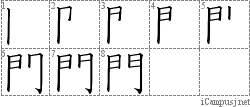Chinese is not one language. It is actually composed of tons of dialects, with Mandarin being the main one. Mandarin (普通话) is an extremely difficult language; writing, reading, and speaking all come with many challenges that don’t seem to exist (well, for me) in English. Some of the mistakes I make (fairly often to be honest) lead to Chinese people and my teachers not understanding what I’ve said or wrote.
Chinese characters (汉字) are very beautiful to look at, but they are often complicated to write. If you forget a dot or a tail, it can be an entirely different character with a whole different meaning. See if you can see the difference in the characters below.
1)贝 / 见 2)泱 / 决 3)已 / 己 4)未 / 末
Yeah, this is why I have to be very careful when I write characters. If I write 周未 instead of 周末 then I’ve written a nonsense word rather than the word for weekend. I’ve found that writing characters in the proper stroke order helps me remember which characters are which. Stroke order is the order in which you write a character.

(http://mandarin-stroke-order-dictionary.clinic007.com)
If you don’t follow the stroke order, the character often looks so strange that even Chinese people will read it wrong. That makes for some awkward misunderstandings on my homework. Then there’s the character that have several different meanings and pronunciations. Most of the time you just have to assume based on context. Take 得 for example. It can mean need or have to (pronounced like “day”) or it can be a grammar structure (pronounced like “duh”). If it follows a pronoun, then it means need or have to; if it follows a verb, then it shows how that verb is done (such as done well, done badly, done fast, etc.).
As complicated as the characters are, pronunciation is without a doubt the hardest part of learning Mandarin. In English, the wrong tone can get you in trouble with your parents or teachers, but when you’re in China, the words “watch your tone” take on a whole new meaning. In Mandarin, tones don’t mean the tone of your voice, but the inflection of your voice when you speak. Mandarin has four official tones, but the neutral tone is also used.
(http://enterarena.blogspot.com/2010/06/mandarin-4-tones-in-chinese-language.html)
I count myself lucky actually. Cantonese has seven. Many foreign students can’t hear the difference in tones. This is a huge problem when we speak because the wrong tone can completely change a character’s meaning. It can be harmless and funny (but still embarrassing) or it can be offensive and cause problems.
shuìjiào (睡觉) = to go to bed, to sleep
shuǐjiǎo (水饺) = boiled dumpling (which are delicious!)
mǎi (买) = to buy, to purchase
mài (卖) = to sell
bèizì (背子) = bad luck
bēizi (杯子) = cup, glass
bèizi (被子) = guilt
cǎo (草) = grass
cào = something that no one says because it is so offensive (not joking)
Now that I am in pronunciation class, I’m more aware than ever of how much pronunciation matters. I can know all the characters in the Chinese language but if other people can’t understand what I am saying because I’m saying it wrong, well, then knowing the characters does me no good. Pronunciation is definitely something I have to master, but I’m willing to learn and China itself is a great teacher.
Bonus! A song created to show the importance of tones.
(http://www.youtube.com/watch?v=2XTBwvi0h2E)
Lila,
Keep up the blogs! They are wonderful…and I’m learning something!
Yours truly,
Peter
下雪的麦考尔。Thinking of you, Peter and Linda